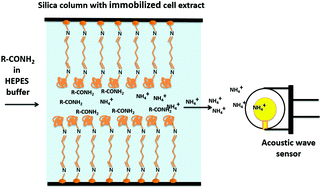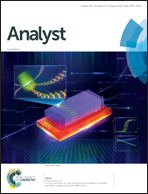Development of a flow injection analytical system for short chain amide determination based on a tubular bioreactor and an ammonium sensor†
Abstract
Pseudomonas aeruginosa (P. aeruginosa) possesses intracellular amidase activity, which catalyses the hydrolysis of short aliphatic amides producing NH4+, and has already been used along with an ammonium ion selective electrode for amide quantification. However, the incorporation of a biological membrane turned to be a challenging process and either the final arrangement was prone to amidase losses or the recovery of the sensor coating after the interaction took too long. In this article a flow injection system with an ammonium acoustic wave sensor is proposed, and after testing several different arrangements for the biological element, the ultimate choice consisted of the immobilization of a P. aeruginosa cell-free extract in the inner wall of a tubular glass reactor, which resulted in a reliable analytical system. Response times less than one minute and complete recovery in less than two minutes assured conveniently fast analysis. The analytical system, as long as the column was properly stored in HEPES buffer containing 2 mM β-mercaptoethanol and 1 mM benzamidine and refrigerated when not in use, could be used at least for 20 working days, along a period of one month, maintaining the initial sensitivity.



 Please wait while we load your content...
Please wait while we load your content...